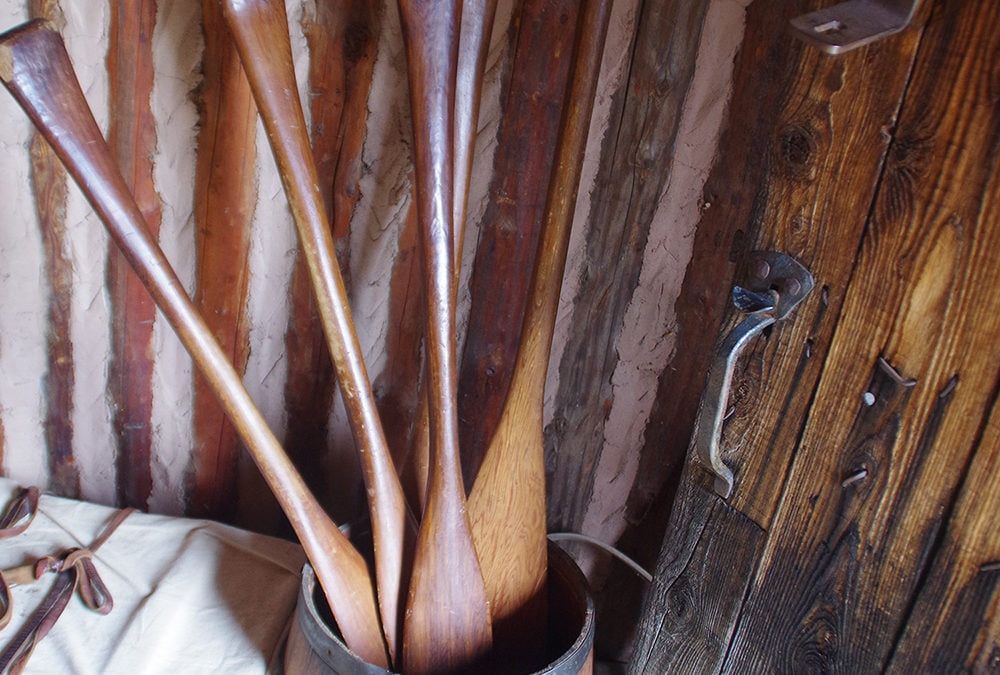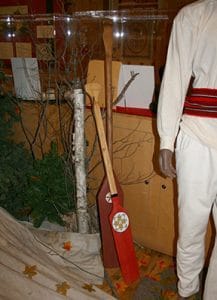
Red paddles at Forts Folle Avoine, Danbury, Wisconsin
A few years ago at a presentation, someone asked me: Why were French-Canadian voyageurs’ paddles red?
We considered a few possibilities:
Was it to show them how deep they should paddle? Not really — within a few hours of paddling, even newbie voyageurs would know that.
Would it help preserve the wood? Maybe, because paddles were constantly in the water.
How would they have made their own preservative or paint, if they had to produce something of their own — in red? Would it stay? Raspberries, beetroot, or vermilion (a trade good), topped with linseed oil — but it probably didn’t last long. Hmmm.
Would red help identify brigades — and why might that be important? Hmmm, again.
While color would give them style and dash in an otherwise plain world, paint would cost money and voyageurs couldn’t waste much on something frivolous.
I puzzled over this, searching old journals. Finding nothing. Not knowing where to even look.
Ask an expert
Finally I contacted Jeremy Ward, curator at the Canadian Canoe Museum in Peterborough, Ontario, Canada. (He’d previously answered my question about the weight of a Montreal canoe.)
Pierre, in Two Harbors, Minnesota
“ Good question. Agreed that voyageurs did not have money to spend on things like paint for personal equipment. The bills of lading issued by the North West Company that show the payload contents, crew names and additional equipment (agrets) includes things like setting poles, ropes (cordelles), tarps (paralas), axe and kettle, repair kit, etc. And no paddles,” Ward wrote.
“This suggests to us that the voyageurs did indeed supply their own paddles. How and when, then, would this rough lot from Montreal area assemble with paddles painted a matching colour? How often were canoes actually paddled using painted paddles (of like colours)?
“Perhaps it might have been more common to see painted paddles in the interior where overwintering voyageurs would have been stationed together and fulfilling chores for the company while waiting for spring canoeing to open up.
I recall learning at some point that, more common than red, Spanish Brown would have been a colour that might have been available and used,” Ward surmised.
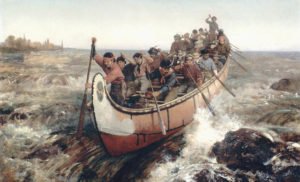
Francis Ann Hopkins, “Shooting the Rapids”
“Perhaps this was actually uncommon and yet we think it common because the best pictorial representations are from Frances Hopkins’ celebrated paintings that show her accompanying her husband to the Lakehead by voyageur canoe. A six-week trip with a distinguished white woman aboard a canoe was a highly unusual event and perhaps this crew were assigned with fancier fare to impress.”
In the spring, after voyageurs had spent winter evenings carving a new one? Not just red? In 1866 and 1868, Frances Ann Hopkins traveled by canoe with her husband, well after steamships and railways changed the fur trade.
Find the right book
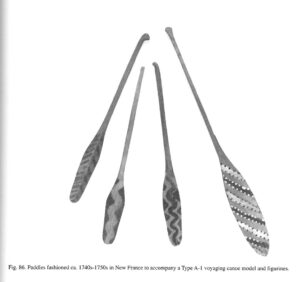
Timothy Kent included these images in his book.
Ward directed me to Timothy Kent’s ”Canoes of the Fur Trade,” Volume 1, whose thorough research in journals and old sources shows how paddles changed over time:
- In 1727, paddles could be purchased from fur trade company stores for one livre apiece. (Wages were 400 livres for a voyageur’s half-year’s work.)
- In 1766, Joseph Cadet ordered “40 well-made and polished paddles of maple.”
- In 1794, Sir Alexander McKenzie described the standard equipment — but no paddles.
- By 1798, “The paddles were supplied by the canoe-men, each bringing his own.” ~ Colonel George Landmann.
- In 1854, the HBC agent at Trois-Riviéres listed the equipment and provisions, with no mention of paddles.
Kent notes that supply lists of standard equipment only occasionally included a spare paddle; thus voyageurs most likely crafted their own, making it fit their own hands and body.
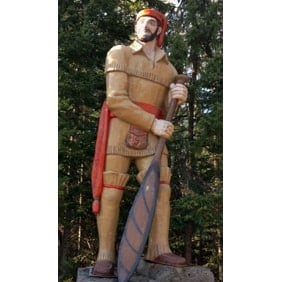
Note the designs in the paddle of Rene Bourassa at Crane Lake, Minnesota.
He devoted one half-page to paddle decoration. Geometric designs predominated from the earliest days (called the French era) if the blade was ornamented, it was more likely with designs — chevrons, straight or wavy black lines, bars and dots.
Color — brownish red, or black, white, green and vermilion red — appeared later.
- By 1859, Robert Kennicott observed, “The blades of all the paddles are usually painted red and ornamented with some markings of black and green.”
- In 1872, Malcolm McLeod noted that paddles were “painted red with vermilion.”
Kent documented much more about the length, width, thickness, shape of blade and grip, wood used, cost when purchased in 1738, the different paddles used by the steersmen and middlemen in the early years of the fur trade! His book is addicting.
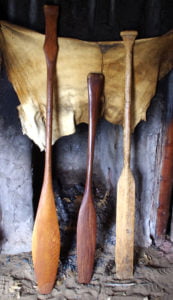
Paddles at the Snake River Fur Post show different sizes, shapes and woods.
He noted that Hopkins mostly depicted the entire blade colored a brownish red, but occasionally the paddle blade had a narrow band of black at its tip and the throat area, and even on the grip.
As Jeremy Ward pointed out, the crew that paddled that young British wife of the governor’s secretary were indeed “select” and probably made sure their paddles were up to the occasion.
So, the truth about red paddles? If voyageurs they had extra time, the right products or a memorable event as a reason to fancy up their paddle, maybe they did use red paddles. Not early in the fur trade era, but later.
Final Thoughts
- Read about the fur trade with my series of novels: I launched Book 3, “Uncharted Waters” in paper and ebook.
- Start from the beginning with Books 1 and 2 — buy “Waters Like the Sky” or “Treacherous Waters” through PayPal. Or the ebook.
- Subscribe to this blog and read posts as they are published!
- Visit me on Facebook or Instagram (@nlnlnraj) for what I’m researching or quirky discoveries: I love your comments.
- Book me as a speaker.
- Ask your library, local school, gift shop to buy copies.
- Become a voyageur for an hour — come to one of my presentations.
- Consider writing fan fiction— your own chapter about what else could happen.
- Create an emoji for me. Here’s my attempt: ͼ!¡¡¡¡¡¡¡!ͻ
Sources:
- “Canoes of the Fur Trade” by Timothy Kent. Silver Fox Enterprises (Ossineke, Michigan, 1997) Volume 1, pages 190-195.
Currently reading:
-
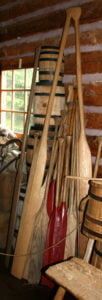
Few of the paddles at Grand Portage National Monument are painted red.
“Fur Trade Nation: An Ojibwe’s Graphic History” written and illustrated by Carl Gawboy (Animikii Mazina’iganan: Thunderbird Press, Cloquet, Minnesota, 2025)
- “Lewis and Clark Through Indian Eyes: Nine Indian Writers on the Legacy of the Expedition” edited by Alvin M. Josephy, Jr.. Vintage Books, New York, 2006)
- “Before Lewis and Clark:The Story of the Chouteaus, the French Dynasty That Ruled America’s Frontier” by Shirley Christian, University of Nebraska Press, Lincoln, 2004)
- “The Journal of Augustus Pelletier: The Lewis and Clark Expedition, 1804” by Kathryn Lasky, Scholastic Books: My Name is America, New York, 2000
- “Our Story of Eagle Woman: Sacagawea, They Got it Wrong” by the Sacagawea Project Board of the Mandan, Hidatsa and Ariakra Nation (The Paragon Agency, Orange, California, 2021)
Featured Image: Canoe paddles at the Snake River Fur Post, Pine City, Minnesota.

